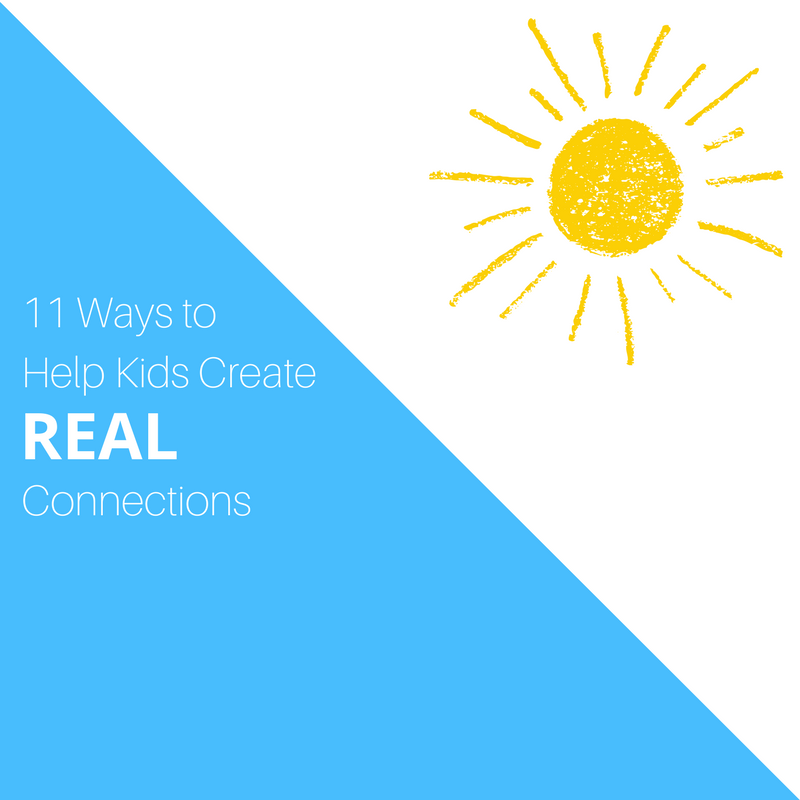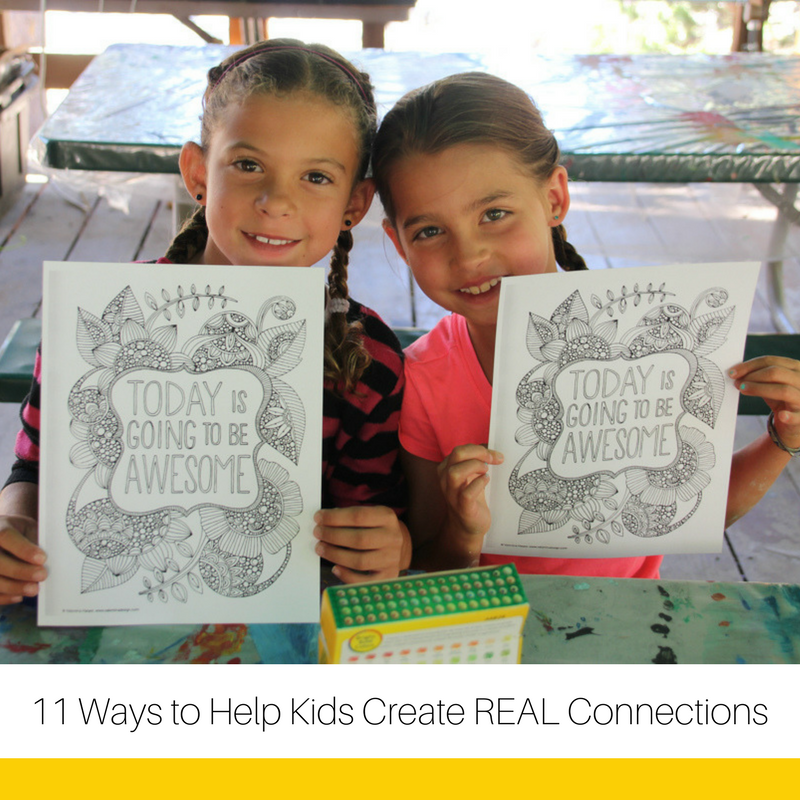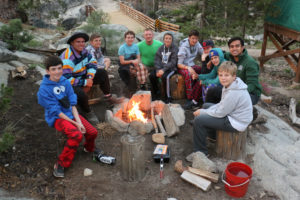11 Ways to Help Kids Create REAL Connections

A 75 year longitudinal study of adult development at Harvard Medical School had two main findings. Researchers George Vaillant and Sheldon Glueck determined that “good relationships”—not wealth or accolades or privilege—“keep us happier and healthier.” Their second, almost tongue-in-cheek finding was that “if alcoholism is not the root of all evil, it is closely correlated with it.”
I’m only going to address the first finding here.
It is the quality of our relationships that best predicts our life-long happiness and health.
Multiple other, shorter-term research studies in the field of positive psychology have confirmed this same finding. More than the things many of us structure our lives and time around – academic and career success, achievement and accolades, or physical appearance and fitness – it is instead focusing on our important relationships that will best predict lifelong happiness and health.
Close relationships, more than money or fame, are what keep people happy throughout their lives.
I know this to be true, as I’ve been studying positive psychology for over a decade. And yet I still find myself, many days, focused more on my tasks than on my people. My Type-A, over-achieving, perfectionist nature make the dopamine boost from checking something off my “to do” list extremely powerful.
Yesterday, I had a much-needed, restorative walk with a close friend who I haven’t seen in person for a while due to our busy family and work schedules. Not only did we get some great exercise outdoors (while leaving our phones behind in our cars), but we also had important conversations about challenges we’re facing and things we’re celebrating. We were able to provide each other with support, and there were both tears and laughter as we walked and talked. Our time together was really important for both of us and left me feeling connected and grateful.
Later, I spent an hour on the phone with a family member, discussing some challenges and providing as much support as I could from afar.
As I looked back over my day, during which – on a tangible level – I didn’t get much of anything done – I realized what a good day it had been, because I had connected with two people who are very important to me.
I know on every level – both from my personal experience and from many documented studies – that time spent with my important people needs to be my top priority. And, yet, as I live my day-to-day life, I usually schedule my time first by looking at what I need to get done. I think I, like many parents, face an almost-daily conflict between things I want to get done and nurturing important relationships, especially with my spouse and children.
In last week’s podcast, my friend Sara and I talked about family pace and space and looking more closely at how our family’s schedule aligns with our values. I think one of the best ways we teach our kids to connect well with others is modeling it for them ourselves – in our connections with them and in our relationships with others they witness. As with all areas of life, relationships and connections are something our kids learn more from how they experience them with us than anything we tell them.
 I’ve compiled a list from some of my favorite resources about ways to foster close connections with our kids – and everyone else we care about:
I’ve compiled a list from some of my favorite resources about ways to foster close connections with our kids – and everyone else we care about:
Acknowledge feelings.
Nothing makes us feel more disconnected than when someone tells us our feelings aren’t valid. When we’re scared about something, it’s not helpful when someone says, “There’s nothing to be scared of.” Instead, we feel better when someone acknowledges our feeling and helps us work through it. For example, we can say, “You seem really scared. What’s making you feel that way?”
Our feelings are our feelings, so they are always valid. If we grew up being told to “buck up” and “deal with it,” we need to switch gears with our own kids and learn how to connect with them over their feelings.
Acknowledging that our kids’ feelings are real, even if they seem nonsensical to us, creates closer connections and also teaches them how to relate to others.
Empathize.
Going a step further than acknowledging feelings is empathizing with them to create an even closer connection. Brene Brown’s video offers a simple but real example of empathy:
People most often think of empathizing regarding hard experiences or negative emotions, but Shelly Gable’s research demonstrated the importance of empathizing over good things. When we truly feel as excited and happy for someone as if their happiness or victory is our own – that is one of the greatest ways to deepen or reinforce our connection with them.
As parents, we often experience this vicarious happiness over our children’s accomplishments. Our child scores a goal, and we feel as happy as if we were the one scoring. While those vicarious feelings can sometimes go a bit too far, that empathic feeling we get is a great example of truly feeling what someone else may be feeling.
Make people feel SEEN, HEARD, and VALUED.
I define connection as the energy that exists between people when they feel seen, heard, and valued; when they can give and receive without judgment; and when they derive sustenance and strength from the relationship.
-Brene Brown, The Gifts of Imperfection: Let Go of Who You Think You’re Supposed to Be and Embrace Who You Are
A few years ago, I found myself deeply involved in an organization in which I was working very hard to contribute and share my gifts. I realized that my work was not being valued and that, in fact, the people there did not really know me – they had not seen me for who I am nor heard the message I was trying to share. I wasn’t looking for accolades, but not feeling seen, heard, or valued at all contributed to my decision to leave an organization of which I’d been a part for almost ten years. I am much more conscious now, as I think of my family members and the people I work with, to remember that everyone needs to feel seen, heard, and valued.
Hug often.
 Physical touch is one of our most basic human needs. Although they often aren’t really reciprocating, I make my teenage sons give me a hug every morning and every night before bed. There appears – based on research – to be a minimum number of hugs people need each day (8). Physical touch is vital for connection, and hugs are a great way to get that touch in.
Physical touch is one of our most basic human needs. Although they often aren’t really reciprocating, I make my teenage sons give me a hug every morning and every night before bed. There appears – based on research – to be a minimum number of hugs people need each day (8). Physical touch is vital for connection, and hugs are a great way to get that touch in.
Play together.
Yet we are hardwired for play and exploration as well as for joining with one another.
Tina Payne Bryson and Dan Seigel, The Whole-Brain Child: 12 Revolutionary Strategies to Nurture Your Child’s Developing Mind
Adults can learn a lot from children when it comes to play. It is through playing together that kids connect, and adults also connect through play, although our play can often be different from kids. Game nights, painting classes, pick-up basketball games, and book club meetings are all examples of what I’d consider adult play. Whether with your spouse, adult friends, or with your kids, finding ways to play together is an important way to connect.
Give Your Full Attention.
The greatest gift we give another person is our time and attention. With our kids, we teach them how to connect with others by modeling it in our relationship with them. If we want them to become adults who set aside their phones and look deep into their loved one’s eyes, giving that person their full attention, we need to show them how to do that both in our interactions with them and with the other people in our lives.
Daily Debrief.
 Any form of daily debrief is a great way to connect. At camp, daily debriefing happens during evening campfire. It’s an ideal setting because everyone’s relaxed, the day is coming to a close, and people are seated in a circle so they can see each other’s facial expressions. Family dinner or bedtime are good times to connect. Figure out a family tradition of sharing something each day – it can be highs and lows of the day, three good things from the day (an excellent gratitude practice), or just sharing a fun story from the day.
Any form of daily debrief is a great way to connect. At camp, daily debriefing happens during evening campfire. It’s an ideal setting because everyone’s relaxed, the day is coming to a close, and people are seated in a circle so they can see each other’s facial expressions. Family dinner or bedtime are good times to connect. Figure out a family tradition of sharing something each day – it can be highs and lows of the day, three good things from the day (an excellent gratitude practice), or just sharing a fun story from the day.
Smile.
If you have only one smile in you, give it to the people you love.
-Maya Angelou
Sometimes I think we save our worst behavior for those closest to us. We smile and offer kindness to a stranger and then neglect to give the same courtesy to those most important to us.
A lot of our communication is non-verbal and those non-verbal behaviors can either repel or attract others. In order to foster close connections, we need to stay aware of what our body and expressions are “saying.”
Use screens to foster connections.
I’m a big advocate for unplugging, which I believe is really important. But I know that screens are a big part of our lives and they’re here to stay. A few years ago, I started thinking about how some of my screen time actually made me feel more connected to others (despite it being on a screen). When I analyzed which connections felt best, I came up with some ideas of using technology to foster closer relationships.
Our family’s group text is a good example. With three of our kids away from home, and two still at home, seeing a text come through and then having interactions with each other is a fun little boost that makes me feel closer to everyone. Another fun way to connect with people is playing an online game with them. Trivia Crack or Words with Friends often lead to offline conversations.
Be You.
One of our camp core values, articulated after hearing it from so many kids over the years, is “be you.” As I (along with millions of others) heard Brené Brown’s important message about how being vulnerable is the only way to form really close relationships, I realized that when people say they can “be themselves” and they “belong,” it means they feel accepted for who they are and don’t feel like they have to represent themselves some way that is not authentic to them.
Daily Rest and Reflection.
Ironically, sometimes it is our alone time that allows us to better connect with others. Regardless of where we are on the introvert-extrovert spectrum, we all need daily time to rest and reflect so that we can refuel ourselves with the energy required for interactions. Taking time to prioritize who I need to connect with each day requires some time to think. We are unique in the ways that best provide rest and reflection, but I would say – universally – that scrolling social media is not restful or reflective. For me, reading a book, going for a walk or run by myself (listening to some uplifting music), and writing in my journal are ways I get some rest and reflection time.
We’re on this quick journey through life together, and having people with whom to go through the valleys and mountain tops is what makes life worth living. So there’s a lot of value in focusing on fostering close connections during every season of our life – and helping our kids do the same.
Resources:
The Secret of Happiness Revealed by Harvard Study, Forbes
The Harvard Study, Harvard Gazette
For Couples, Reaction to Good News Matters More Than Reaction to Bad, NY Times
The Whole-Brain Child: 12 Revolutionary Strategies to Nurture Your Child’s Developing Mind, Tina Payne Bryson and Dan Siegel
